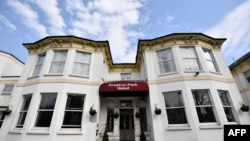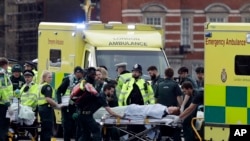So much is known now about the 52-year-old man who killed four people Wednesday and injured dozens of others on Westminster Bridge and in London's Parliament Square.
So much, but so little.
His last dinner before the rampage was a kebab, eaten at a cheap hotel in the southern coastal town of Brighton, 87 kilometers from London. The hotel staff said there was nothing to suggest he was on the eve of adding his name to the roster of jihadists who have died while carrying out recent atrocities in Europe.
He was affable and smiling, and he told staff he was visiting friends in Brighton, a seaside resort popular with day-trippers and in recent years associated with gay chic.
The manager of the hotel told reporters the terrorist had been "laughing and joking, telling us stories about where he lived" just hours before the attack. His past public disorder offenses are all known too — from assault to slashing a man's face in a pub brawl.
Childhood in Kent
British television channels Friday flashed school photographs of Khalid Masood, then known as Adrian Russell Ajao — the family name coming from his stepfather. He was born Christmas Day, 1964. As a schoolboy in a leafy, picturesque and almost exclusively white Kent village he was soccer-mad, played rugby, got into body-building and experimented with drugs.
A childhood friend has hinted he may have been the target of some racism at school. "He was a big character, very friendly and a good laugh," Kenton Till told Britain's Daily Mail newspaper. "He might have been the only black kid at the school. He experienced a little bit of racism," he added, though, "not a lot because he always tried to be popular."
Till continued, "We used to socialize together up until we left school but he turned up to a party at my house with some friends after they had been smoking puff [cannabis] and my mum threw them all out. We sort of lost touch after that."
In the immediate years after school, he worked for the family firm, selling cleaning supplies and moved in with a woman four years his junior.
And then, for reasons still unclear, it all started to go wrong.
Police were often called to his home, which he shared with then wife Jane Harvey, who gave birth to two of Khalid Masood's three children.
Friends told the Sun newspaper that Khalid Masood would go into drink-fueled rages. The couple split in 2000 after he slashed the face of a cafe owner in a pub brawl that earned Masood two years in prison.
The killer blamed racism for the fight, telling a court he slashed a cafe owner's face because he was "ostracized" by people in the village in East Sussex where he was then living. The judge who sentenced him noted: "While it doesn't afford any excuse for your behavior it may afford some degree of explanation."
But his violence in nearly all the public order cases against him over the years went hand-in-hand with excessive drinking — before the 2000 pub brawl he consumed four pints of beer.
While the childhood and psychological background of Khalid Masood is engrossing for radicalization experts (and the British media), who want to understand what drove him to kill, it is only of minor interest for police investigators who have more immediate and urgent questions to find answers to — among them, when, why and how he was radicalized.
As the police sift through the biographical scraps of his past, they are trying to discover as quickly as possible whether he acted alone or was he directed to target the House of Commons. Was he part of a network of like-minded radicals, who are plotting further carnage?
Two years in prison
The date of his conversion to Islam is not clear, but the suspicion is that he was radicalized while serving a two-year sentence for the 2000 slashing incident in the pub.
In several European countries, the majority of jihadist recruits are former criminals. There hasn't been a merging of criminal organizations with Islamic State and other jihadist groups but there has been a partial merging of social networks, environments, and milieus. Criminal and terrorist groups are recruiting from the same pool of people, creating dangerous synergies, say analysts.
The men who carried out the 2015 Paris and Brussels attacks had long histories of delinquency — and some are known to have been recruited while serving prison terms or were recruited by men whose radicalism had started in jail.
Since Wednesday police have raided homes across Britain and arrested so far 11 people, some on suspicion of participating in the preparation of terrorist acts. They include a 27-year-old man from Birmingham and a woman, age 32, from Manchester.
"All of them are being quizzed as we try to piece together what went into the attack," a senior police official told VOA. The police investigation, code-named Operation Classific, is being led by officers from SO15, the London Metropolitan Police's counter-terrorism squad.
Acting Deputy Commissioner Mark Rowley Friday said: "Whilst there is no evidence of further threats you will understand our determination to find out if he either acted totally alone inspired by terrorist propaganda; or, if others have encouraged, supported or directed him."
Three minutes before he drove his rented Hyundai SUV at pedestrians, plowing into them as they walked over Westminster Bridge, Khalid Masood was in contact with someone via the encrypted messaging service WhatsApp.
Police are trying to identify who that person was and what was the nature of the conversation.
Years in Saudi Arabia
Where he lived in the past is also drawing attention. According to London police officials who talked with VOA, Khalid Masood is thought to have lived for several years in Saudi Arabia. The Sun newspaper has reported that he moved to the Gulf kingdom in 2005 and for four years taught English in Yanbu to civil aviation workers.
Was it in Saudi Arabia that his radicalization deepened?
And in 2009 he moved to Luton, just north of London, again to teach English, part-time. The choice of Luton might be significant as was his decision later to move to Birmingham. Both towns have figured prominently in the recruitment of Britons by the Islamic State terror group.
The July 7, 2005 London bombers had connections to the town and both towns have attracted regular visits from extremist preachers, including in the past Abu Hamza, Omar Bakri Mohammed and Anjem Choudary, an influential radical cleric who was jailed last year on terror offenses and has been linked by British police to 15 terror plots since 2000.
It was during his time in Luton and Birmingham, that Khalid Masood drew the fleeting attention of Britain's security services. Midweek, British Prime Minister Theresa May told the House of Commons, "Some years ago, he was once investigated by MI5 in relation to concerns about violent extremism. He was a peripheral figure; the case was historic; he was not part of the current intelligence picture."
He also appeared to neighbors in Luton as 'peripheral,' One of his neighbors described him to British reporters as "a shadow." "I didn't see him often. Sometimes I would see him walking around at night. I didn't see him during the day. It was hard to tell he was living there."
For British police, the concern is that they may have missed the importance of other 'peripheral figures.'












